Osprey Roundup
I’m sorry that there was no Roundup last month, but no books arrived
for review until after the deadline for the February issue. This time
you get two months’ worth instead!
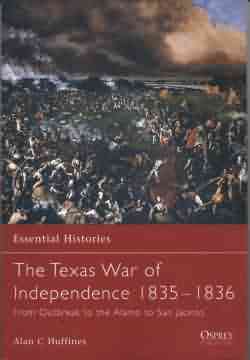 Essential
Histories, The Texas War of Independence 1835-1836 From Outbreak to the
Alamo to San Jacinto, by Alan C Huffines, ISBN 1-84176-522-8, 96 pages Essential
Histories, The Texas War of Independence 1835-1836 From Outbreak to the
Alamo to San Jacinto, by Alan C Huffines, ISBN 1-84176-522-8, 96 pages
I’m starting with this one because I like it so much. It gives
the political background to events, including the several Mexican revolutions
and swings from Republican to Centralist power that complicated the Texans’ original
search for a measure of self-government. Then comes the actual Texan
declaration of independence and the Mexican oppression, including the
massacre of prisoners who had merely been in the area of fighting. Terror
was one of Santa Anna’s explicit weapons. The actual battles get
less attention, having already been covered in other Osprey books, but
there’s quite enough here to show what happened without a blow-by-blow
account. Highly recommended to anyone with an interest in Texas or US
history.
 Fortress
28, Forts of the American Frontier 1820-91, Central and Northern Plains,
by Ron Field, illustrated by Adam Hook, ISBN 1-84176-775-1,64 pages Fortress
28, Forts of the American Frontier 1820-91, Central and Northern Plains,
by Ron Field, illustrated by Adam Hook, ISBN 1-84176-775-1,64 pages
Following on, here’s one for Western fans. It’s full of old
photographs of the forts, and has excellent plates of them to show general
layouts as well as details. Lovers of the John Wayne cavalry films may
get a shock to realise that many of the forts had neither walls, stockades
or even proper gates – the howling Comanche climbing the high stockade
seems never to have existed. But some did have those accoutrements and
anyone wanting to show US Cavalry or Infantry models in their true environment
will find this book invaluable. Recommended!
 Fortress
27, French Fortresses in North America 1535-1763, Québec, Montréal,
Louisbourg and New Orleans, by René Chartrand, illustrated by
Donato Spedaliere, ISBN 1-84176-71-X, 64 pages Fortress
27, French Fortresses in North America 1535-1763, Québec, Montréal,
Louisbourg and New Orleans, by René Chartrand, illustrated by
Donato Spedaliere, ISBN 1-84176-71-X, 64 pages
Here we go further back in time to the French colonial period in North
America. The fortified cities are well described and shown in good illustrations
and colour plates, and the smaller forts are not neglected. The several
sieges are also described. Readers may be surprised to realise just how
small the “cities” were in those days – mostly with far
fewer people than the small market town where I live in England. If North
American history is your interest you’ll need this book , Recommended
to Canadian readers in particular for its coverage of Montréal
and Québec.
New Vanguard 86, M109 155mm Self-propelled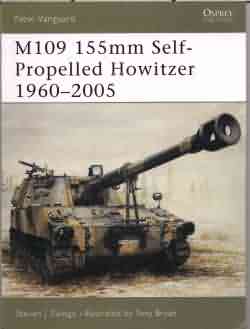 Howitzer 1960-2005, by Steven J Zaloga, illustrated by Tony Bryan, ISBN
1-84176-631-3, 48 pages
Howitzer 1960-2005, by Steven J Zaloga, illustrated by Tony Bryan, ISBN
1-84176-631-3, 48 pages
This is a very interesting account of the development and service use
of the M109 and also the M108 105mm SPH. The first chapter describes
the various designs that were tested and used before the new M108 and
M109 emerged in the late 1950s and then deals with the new vehicles’ characteristics.
Then service use in Vietnam is described. Post-Vietnam developments take
two chapters, looking at the quests for longer range and for more lethal
shells including area-effect sub-munitions and the special nuclear and
chemical warheads. Then comes Israeli use of the M109, followed by a
chapter on precision-guided munitions. Next is a comprehensive look at
how the M109 has been improved to the new Paladin and at the FAASV ammunition
transporter, with service in both Gulf Wars covered last. The final chapter
is about foreign users and the modifications they have made.
The differences between the basic M109 and the A1/A2/A3/A4/A5/A6 versions
are clearly stated, making this an excellent reference for modellers
working with the several Italeri/Testors kits, and the photographs and
colour plates cover non-US use of the series as well as US Army service.
Very highly recommended!
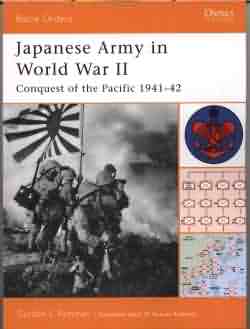 Battle
Orders 9, Japanese Army in World War II, Conquest of the Pacific 1941-42,
by Gordon L Rottman, ISBN 1-84176-789-1, 96 pages Battle
Orders 9, Japanese Army in World War II, Conquest of the Pacific 1941-42,
by Gordon L Rottman, ISBN 1-84176-789-1, 96 pages
This is a detailed examination of the Japanese Army at the beginning
of World War 2. It begins with how the Imperial Army was created back
in the 1870s and its development until 1941. Next come details of the
divisions involved in the 1941/42 fighting, with campaign histories of
each. Then the Japanese doctrine is described, mainly based on the attack,
and the unit organisations at all levels with notes on unit designation,
task force organisation and tank regiments. A useful table of the tank
types in each regiment is included. Tactics, weapons and equipment including
artillery and tanks as well as small arms, and command and communications
each get a chapter. Finally there’s a long chapter on combat operations,
examining the Japanese attacks on the Philippines, Bataan and Corregidor,
the Dutch East Indies, Borneo and New Guinea. Malaya, Singapore and China
are not included, not being part of the Pacific area and therefore no
doubt left for one of the future books promised. Plenty of maps show
the courses of the campaigns and there are orders of battle for each
force.
This is a must-buy for anyone interested in the 1941/42 fighting. Recommended!
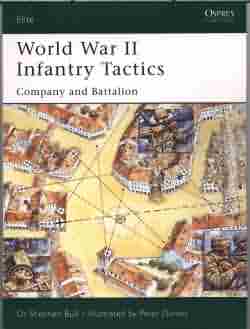 Elite
122, World War II Infantry Tactics, Company and Battalion, by Dr Stephen
Bull, illustrated by Peter Dennis, ISBN 1-84176-663-1, 64 pages Elite
122, World War II Infantry Tactics, Company and Battalion, by Dr Stephen
Bull, illustrated by Peter Dennis, ISBN 1-84176-663-1, 64 pages
This is a very interesting book, dealing with the tactics used by German,
British and US units not only in theory but in actual actions. Infantry
weapons, machine guns, mortars, mines and antitank tactics are all covered.
There’s also a chapter on motorised and armoured infantry showing
how the tactics of the three armies differed, and one about co-operation
with tanks. Actual combat examples are used throughout the book, and
the photographs and plates are informative too. This is a great reference
for diorama builders as well as fascinating to read. Recommended.
Campaign 147, Crete 1941, Germany’s lightning 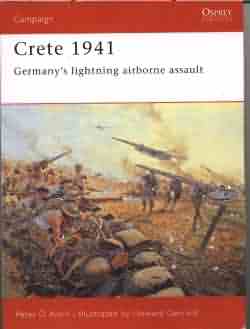 airborne
assault, by Peter D Antill, illustrated by Howard Gerrard, ISBN 1-84176-844-8,
96 pages airborne
assault, by Peter D Antill, illustrated by Howard Gerrard, ISBN 1-84176-844-8,
96 pages
This was the Fallschirmjaegers’ last mass airborne attack and it
is well described here. The very detailed analysis shows how the fog
of war prevented better decisions by the defenders and goes right through
to the evacuation from Sphakion, with credit to the Royal Navy for its
part. This book will give tank modellers some new ideas for models of
the Matilda and Light Tank Mk VI tanks used in the defence, though unfortunately
very few photographs of them were taken and no markings are visible on
the one shown here. Recommended.
Battle Orders 10, US Tank and Tank Destroyer Battalions in the ETO 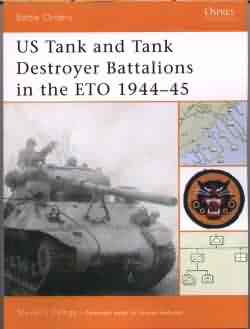 1944-45,
by Steven J Zaloga, ISBN 1-84176-798-0, 96 pages 1944-45,
by Steven J Zaloga, ISBN 1-84176-798-0, 96 pages
This is a really good reference, not just a list of units and their
composition. The tank battalions here are the “separate” ones
at Army level, not those in armoured divisions. The infighting that resulted
in daft ideas gaining official acceptance is described both for tanks
and tank destroyers. The unit organisation chapter gives details of the
separate tank battalions and the tank destroyer battalions, with descriptions
of how their organisations changed over time. Their equipment is considered
too, including T10 Shop Tractors, DD tanks, mine rollers, and mine flails,
and both SP and towed tank destroyers. Tables give all the various battalion
tables of organisation and equipment, backed up by excellent pictorial
graphs, plus the actual tank and tank destroyer strengths in the ETO
at various dates. A long chapter gives examples of actual combat from
the Normandy landing to assaults of fixed fortifications and meeting
a panzer counter-attack, and finally there are brief histories of all
the separate tank battalions and tank destroyer battalions, in most cases
with notes on their equipment. Highly recommended!
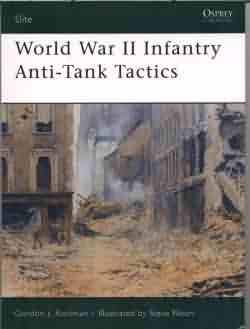 Elite
124, World War II Infantry Anti-Tank Tactics, by Gordon L Rottman, illustrated
by Steve Noon, ISBN 1-84176-842-1, 64 pages. Elite
124, World War II Infantry Anti-Tank Tactics, by Gordon L Rottman, illustrated
by Steve Noon, ISBN 1-84176-842-1, 64 pages.
This book gives everything you could possibly want to know about its
subject. It looks at infantry’s vulnerability to tanks and tanks’ vulnerability
to infantry, and then goes on to describe all the basic anti-tank weapons
from anti-tank rifles and small-calibre anti-tank guns to bazookas and
anti-tank grenades, including a discussion of the various types of projectile
and their uses. Then there’s an examination of anti-tank tactics
and finally a long chapter looks at all the actual weapons of each main
combatant and the tactics used to employ them. The many photographs and
plates of the major weapons show how they were used. This book is essential
if you build dioramas that feature opposing infantry and tanks. Recommended!
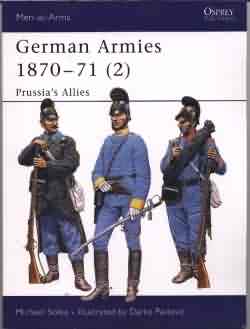 Men-at-Arms
422, German Armies 1870-71 (2) Prussia’s Allies, by Michael Solka,
illustrated by Darko Pavlovic, ISBN 1-84176-755-7, 48 pages Men-at-Arms
422, German Armies 1870-71 (2) Prussia’s Allies, by Michael Solka,
illustrated by Darko Pavlovic, ISBN 1-84176-755-7, 48 pages
Here are the “other” German troops of the Franco-Prussian War, often
neglected but very well treated here. Baden, Bavaria, Brunswick, Hesse-Darmstadt,
Mecklenburg, Saxony, and Wurttemberg are all included with descriptions of
their infantry, cavalry and artillery uniforms. The good colour plates are
backed up by monochrome reproductions of older plates by such authorities as
Knotel, making this a great reference for figure modellers.
Warrior 96, Carolingian Cavalryman 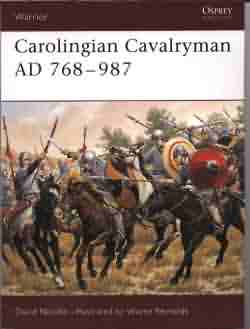 AD768-987,
by David Nicolle, illustrated by Wayne Reynolds, ISBN 1-84176-645-3, 64
pages AD768-987,
by David Nicolle, illustrated by Wayne Reynolds, ISBN 1-84176-645-3, 64
pages
Fans of ancients and medievals will need no more that the name of David
Nicolle to buy this book. For the rest of you, it covers some fascinating
early cavalrymen in good detail and will provide plenty of figure modelling
ideas. Recruitment, training, life, clothing and equipment, and battles
are all here. The illustrations are excellent, with many photographs
of surviving statues and manuscript illuminations, and the colour plates
are just as good. Yes, the death of Roland at Roncesvalles is among the
plates though the famous Song of Roland is not quoted as a source! Highly
recommended.
Campaign 148, Operation Barbarossa 1941 (2) Army Group North, by Robert
Kirchubel, illustrated by H 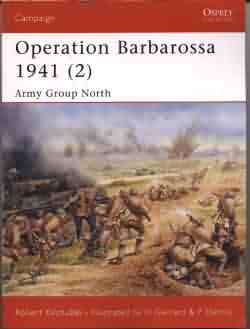 Gerrard
& P Dennis, ISBN 1-84176-857-X, 96 pages Gerrard
& P Dennis, ISBN 1-84176-857-X, 96 pages
This is a clear account of operations up to the siege of Leningrad,
and makes it clear that shifting and poorly-defined objectives were almost
as much to blame as the weather for the German failure to take Leningrad.
Finnish operations stopped short of the city, since all Finland really
wanted was to regain its pre-1939 frontiers and Stalin had warned of
wrath to come if they went any further. The campaign is well described,
with excellent coverage of the fighting accompanied by birds’-eye
views and maps. The photographs are a mixture, concentrating mainly on
the men and their commanders but with some tanks and equipment – however
since this is not a modelling reference but a campaign history they do
their job. The plates are atmospheric but readers will boggle gently
at some of the tanks shown, which seem a bit distorted. Recommended as
a history since there’s so little in print in the English language
about the Northern Front of the Russian Campaign.
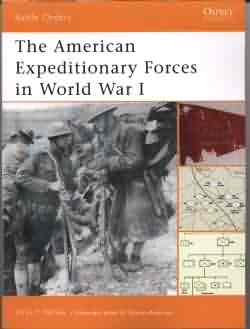 Battle
Orders 6, The American Expeditionary Forces in World War I, by John F
Votaw, ISBN 1-84176-622-4, 96 pages Battle
Orders 6, The American Expeditionary Forces in World War I, by John F
Votaw, ISBN 1-84176-622-4, 96 pages
This is an excellent book for anyone interested in the WWI doughboy.
It gives a great deal of detail about how the US Army was organised in
the first place to grow to its eventual size, with its doctrine and training.
The idea behind US doctrine at the time was “open field warfare”,
in other words the attack as opposed to the defensive trench warfare
actually practiced on the Western Front. Training was aimed at this,
and not surprisingly led to high casualties since neither men nor officers
were trained for what really faced them. There are pen pictures of the
main commanders, details of unit organisation from AEF level downwards,
and examples of actual combat. Infantry, air, artillery and tanks are
all covered. Recommended!
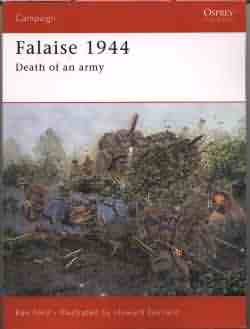 Campaign
149, Falaise 1944 Death of an army, by Ken Ford, illustrated by Howard
Gerrard, ISBN 1-84176-626-7, 96 pages Campaign
149, Falaise 1944 Death of an army, by Ken Ford, illustrated by Howard
Gerrard, ISBN 1-84176-626-7, 96 pages
This is great! Most coverage of the Normandy campaign has focussed on
the D-Day landings, on Operation Cobra or on small sections of the battle,
but here we get the whole story of how the Falaise Pocket was created
by hard fighting co-ordinated between Commonwealth, US, and Polish forces.
The French also get a look-in but this mainly shows their ineffectiveness
at this time. The French Resistance is not included. Contrary to many
assumptions, it was not Montgomery’s decision to pin German forces
by attacking on his front – it was Eisenhower’s. This allowed
the eventual US breakout and the formation of the Falaise Pocket, and
the whole story is given of how switching attack points back and forth
along the whole Normandy front led to both. There are good maps, and
the birds’-eye views of important parts of the continuing battle
are very helpful. Osprey has rearranged the captions to these so you
don’t have to search around the edge of the view to find the next
one, making them much easier to use. Highly recommended.
|
|
 Essential
Histories, The Texas War of Independence 1835-1836 From Outbreak to the
Alamo to San Jacinto, by Alan C Huffines, ISBN 1-84176-522-8, 96 pages
Essential
Histories, The Texas War of Independence 1835-1836 From Outbreak to the
Alamo to San Jacinto, by Alan C Huffines, ISBN 1-84176-522-8, 96 pages Fortress
28, Forts of the American Frontier 1820-91, Central and Northern Plains,
by Ron Field, illustrated by Adam Hook, ISBN 1-84176-775-1,64 pages
Fortress
28, Forts of the American Frontier 1820-91, Central and Northern Plains,
by Ron Field, illustrated by Adam Hook, ISBN 1-84176-775-1,64 pages Fortress
27, French Fortresses in North America 1535-1763, Québec, Montréal,
Louisbourg and New Orleans, by René Chartrand, illustrated by
Donato Spedaliere, ISBN 1-84176-71-X, 64 pages
Fortress
27, French Fortresses in North America 1535-1763, Québec, Montréal,
Louisbourg and New Orleans, by René Chartrand, illustrated by
Donato Spedaliere, ISBN 1-84176-71-X, 64 pages Howitzer 1960-2005, by Steven J Zaloga, illustrated by Tony Bryan, ISBN
1-84176-631-3, 48 pages
Howitzer 1960-2005, by Steven J Zaloga, illustrated by Tony Bryan, ISBN
1-84176-631-3, 48 pages Battle
Orders 9, Japanese Army in World War II, Conquest of the Pacific 1941-42,
by Gordon L Rottman, ISBN 1-84176-789-1, 96 pages
Battle
Orders 9, Japanese Army in World War II, Conquest of the Pacific 1941-42,
by Gordon L Rottman, ISBN 1-84176-789-1, 96 pages Elite
122, World War II Infantry Tactics, Company and Battalion, by Dr Stephen
Bull, illustrated by Peter Dennis, ISBN 1-84176-663-1, 64 pages
Elite
122, World War II Infantry Tactics, Company and Battalion, by Dr Stephen
Bull, illustrated by Peter Dennis, ISBN 1-84176-663-1, 64 pages airborne
assault, by Peter D Antill, illustrated by Howard Gerrard, ISBN 1-84176-844-8,
96 pages
airborne
assault, by Peter D Antill, illustrated by Howard Gerrard, ISBN 1-84176-844-8,
96 pages 1944-45,
by Steven J Zaloga, ISBN 1-84176-798-0, 96 pages
1944-45,
by Steven J Zaloga, ISBN 1-84176-798-0, 96 pages Elite
124, World War II Infantry Anti-Tank Tactics, by Gordon L Rottman, illustrated
by Steve Noon, ISBN 1-84176-842-1, 64 pages.
Elite
124, World War II Infantry Anti-Tank Tactics, by Gordon L Rottman, illustrated
by Steve Noon, ISBN 1-84176-842-1, 64 pages. Men-at-Arms
422, German Armies 1870-71 (2) Prussia’s Allies, by Michael Solka,
illustrated by Darko Pavlovic, ISBN 1-84176-755-7, 48 pages
Men-at-Arms
422, German Armies 1870-71 (2) Prussia’s Allies, by Michael Solka,
illustrated by Darko Pavlovic, ISBN 1-84176-755-7, 48 pages


